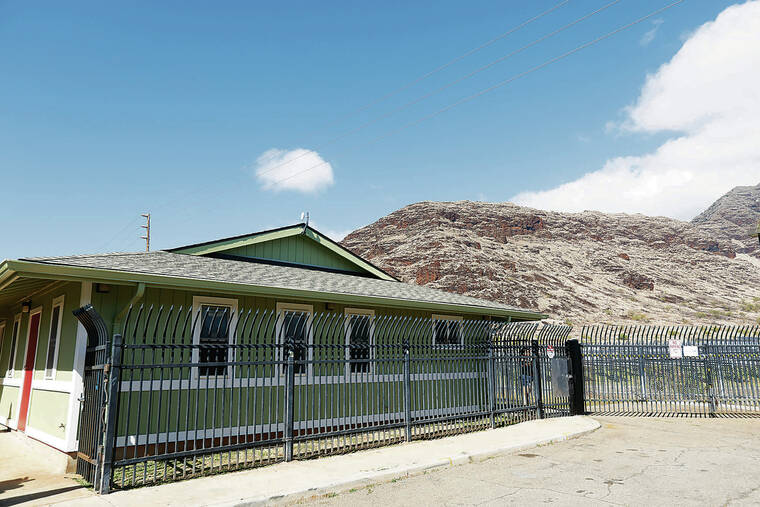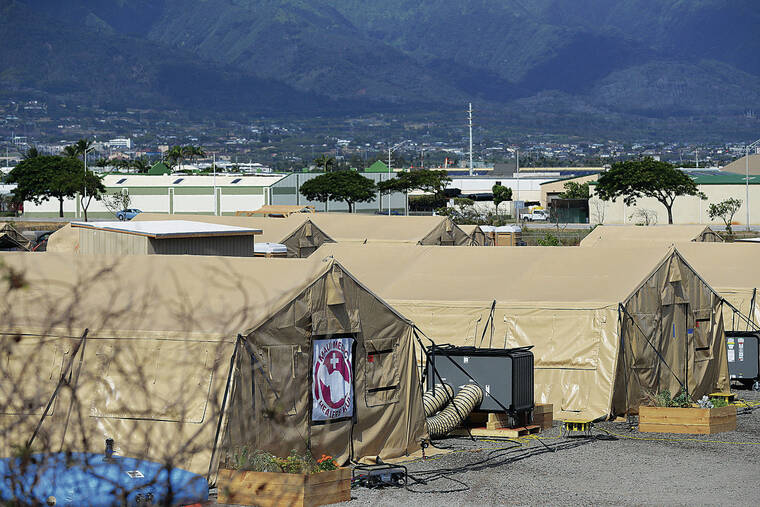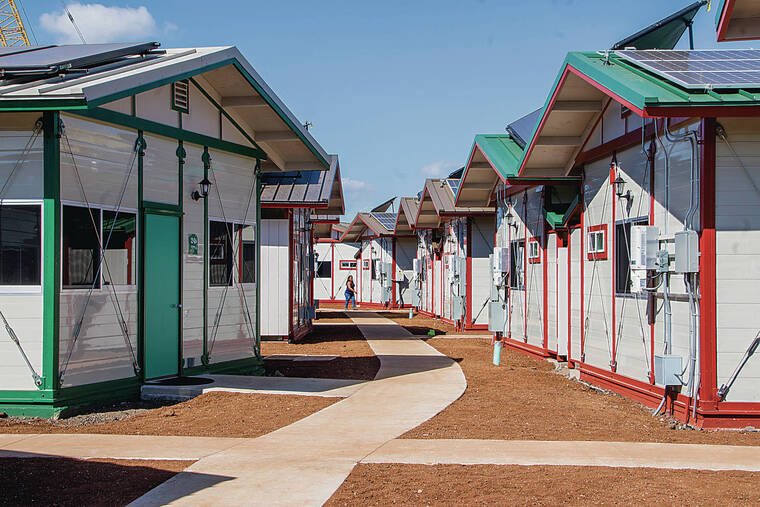Hawaii could see its biggest one-time investment ever from state leaders this year to house the homeless.
Gov. Josh Green has asked the Legislature to include $100 million in the state budget over the next two fiscal years to fund the development and operation of communal housing, or kauhale, and many lawmakers are buying in.
All 42 Democrats in the 51-member House of Representatives have introduced a bill proposing the same amount of money for what is described as the “kauhale initiative.”
Green said $100 million would fund a dozen new kauhale, including support services, and realize a goal he’s set to cut the size of Hawaii’s homeless population in half during his current four-year term as governor, which runs through the end of 2026.
Such a goal, according to the Statewide Office on Homelessness and Housing Solutions, has never been achieved by any state and would be a big accomplishment for Hawaii, which has one of the highest per capita rates of homelessness among states.
“The state of Hawaii can be great in this space,” Green said Thursday at a blessing ceremony for a transitional shelter and long-term housing project for the homeless in Waianae that he described as the 18th kauhale produced since 2018, when he began championing the initiative as lieutenant governor.
Green describes his goal, which also includes having 30 kauhale villages representing more than 1,500 housing units by the end of 2026, as ambitious. But he also said he has no doubt that it will be met.
The most recent Point in Time Count from 2024 showed that 6,389 people were experiencing homelessness in Hawaii.
Green said his administration so far has opened or provided funding for 18 kauhale with 835 beds. Some of these projects were led by the state, though most have been led by nonprofit organizations or the city with contributions from the state.
Also, only about half the projects are clusters of small, single-occupancy units with shared kitchen and bathroom facilities typically referred to as kauhale.
The original concept of what constituted a kauhale has been broadened in recent years to describe almost any kind of housing for the homeless, including single-family homes with multiple tenants, apartment buildings and even temporary tents used as emergency shelters.
Kauhale origins
Green’s kauhale initiative was inspired by a visit in 2018 he made as lieutenant governor to a village of tiny homes to house the homeless in Austin, Texas. The project called Community First! served more than 200 formerly homeless people at the time.
The word ‘kauhale’ in Hawaiian literally means a group of houses or can refer to a small settlement or hamlet.
In his State of the State speech to the Legislature on Tuesday, Green said, “Kauhale are communal villages that offer tiny homes for the homeless. They offer shared space for cooking, eating, recreation, growing food and community activities, even job training.”
Green also has said kauhale include other forms of housing with some aspect of communal living. At Thursday’s blessing ceremony for the project in Waianae, which does not include tiny living units, he noted that kauhale can come in “many shapes and forms and flavors.”
What is now described as being the first kauhale developed since Green took up his initiative as lieutenant governor is Kahauiki Village near Keehi Lagoon. Local businessman Duane Kurisu spearheaded the plan through his nonprofit aio Foundation, which described it at the time as unprecedented in Hawaii.
Kurisu reused prefabricated modular homes that had been made as part of a relief effort for the 2011 earthquake, tsunami and nuclear disaster in Fukushima, Japan. Building Kahauiki Village, which occupies state land, began in 2017, and an initial phase opened in 2018. Today there are 60 one-bedroom units and 80 two-bedroom units operated by the nonprofit Institute of Human Services.
In 2021, Kama‘oku Kauhale became the first kauhale spearheaded by Green and featured 36 units measuring about 100 square feet each. This project in Kalaeloa operated by the nonprofit organization U.S.VETS was designed to provide permanent housing for veterans experiencing chronic homelessness.
Kama‘oku Kauhale was built on state land and involved the Hawaii Public Housing Authority and the nonprofit HomeAid Hawaii. The Harry and Jeanette Weinberg Foundation also contributed funding.
Different flavors
Currently, several other kauhale on the list of 18 are made up of tiny homes clustered together. One of these is Hui Mahi‘ai Aina, which was developed in 2020 initially without authorization on state land in Waimanalo by community members led by “Auntie Blanche” McMillan.
Others include a cluster of 50 plastic storage sheds set up initially without permits on a Waianae farm in 2021 by an affiliate of Hawaii Cedar Church, and two state-led projects that opened in 2024: Ho‘okahi Leo Kauhale, with 50 units on Middle Street in Kalihi, and Ka Malu Koolau, with 34 units in Kaneohe.
Other types of housing for the homeless that are part of the 18 kauhale projects involving the state range from an apartment tower to tents.
The tower project is on Kapiolani Boulevard featuring 108 studio apartments that the city bought from Tokai University in 2022 for $38 million and renamed Waikiki Vista.
In 2022, IHS began creating what it initially called the Village of Redemption on Oahu with one single-family home serving as transitional housing for men recently released from incarceration. This project, now known as Redemption Kauhale, includes a second single-family home on a separate property, and a third property with a main house and five tiny units. In all, 40 beds are in use, and six more are to be added at one of the three properties.
Another kauhale, called ‘Apapane, was created by RYSE, a nonprofit, using a renovated six-bedroom home on Oahu that serves as transitional housing for youth recovering from substance abuse.
On Maui the 150-bed Pu‘uhonua o Nene emergency shelter, established on state land in 2023 with several large air-conditioned tents for homeless people affected by the Maui wildfires, also is counted as one of the state’s 18 kauhale projects.
The most recent addition to the list was blessed Thursday in Waianae. It includes 19 beds in one dorm building for short-term transitional use and 12 apartments ranging from studios to three-bedroom units for permanent use. Both components were developed in 2008 by a nonprofit on state land and are within the existing low-income rental housing complex Kulia i ka Nu‘u.
“Every different way to get a roof over someone’s head is part of our kauhale program now,” Green said in an interview. “The goal to reduce unsheltered homelessness by half is served by any of these different models.”
Money-saving model
Green, in his State of the State speech, stressed to lawmakers that a model that provides health care services in conjunction with transitional or permanent housing is optimal and saves taxpayers money. Several existing kauhale projects, including the newest one in Waianae, include health care services.
According to a recent University of Hawaii Center on the Family report cited by Green, health care costs for the average person living on the street dropped by 76% to $1,965 a month after being housed for six months, down from about $8,000 per month.
Green also is seeking $10.8 million from the Legislature to support family assessment centers, the Housing First Program, the Rapid Re-housing Program, homeless outreach and civil legal services.
“With these innovations and investments, over the next five years we project a net savings after all costs of over $450 million for Hawaii taxpayers at the same time that we are reducing homelessness and caring for people in need,” he told lawmakers.
John Mizuno, statewide homelessness and housing solutions coordinator in Green’s office, is a little less optimistic than the governor about having 30 kauhale projects by the end of 2026. His estimate is 2027 or maybe even 2028.
Still, Mizuno said the more that get added will increase savings to state revenue. He said the $1.2 million annual cost for the state fund operations at the new facility in Waianae to serve 70 to 80 people compares with nearly $6.2 million the state would typically spend on annual emergency room visits for 75 people living without housing.
Broad backing
There have been big legislative appropriations in recent years to reduce homelessness, but not as much as currently proposed.
In 2018 the Legislature appropriated $30 million to establish an “ohana zones” pilot program, which helped nonprofits and county agencies pay for a broad range of largely undefined things that included roof repairs at homeless shelters to prevent them from shutting down, social service workers’ salaries and government housing vouchers to subsidize permanent housing.
In 2020 the House shelved a bill that Green as lieutenant governor had sought to establish a $20 million one-year kauhale pilot program.
More recently, Green has sought and received funding for his kauhale initiative: $15 million for the fiscal year ended June 30, 2024, and $33 million in the current fiscal year, ending June 30.
This year the Democratic caucus in the House is on board with Green’s kauhale funding request for $50 million in each of the next two fiscal years, with the recognition that such housing can encompass many forms of shelter.
“Over time, the kauhale initiative has evolved to a range of responses for homeless individuals and families and those at risk of homelessness,” House Bill 431 states. “Kauhale now include temporary, time limited options such as emergency shelter, medical respite, and mobile outreach and navigation, as well as long term solutions such as supportive housing and affordable housing targeting extremely low-income households.”
Rep. Lisa Marten, chair of the House Committee on Human Services and Homelessness, said the bill from the caucus reflects a collective goal and priority of the Democratic members of the House as well as an endorsement of Green’s budget request.
”It is agreeing with the governor’s significant ask,” she said. “This is our way of saying, ‘Yes, we’d like to support that ask in the budget.’”
HB 431 also goes further by proposing that a state agency that helps finance private affordable-housing development receive $24 million over the next two fiscal years to help developers create housing for people with special needs, including youth aging out of foster care, domestic violence survivors, people struggling with alcohol or drug addiction, people transitioning from incarceration and people with mental illness.
Marten (D, Kailua-Lanikai-Waimanalo) agrees that the state will save money on health care for the homeless by providing housing, and she also said communities where homeless populations decline will benefit in addition to the people living in unhealthy conditions on the street.
“When we get our chronically homeless off the street, it makes a huge difference in our communities,” she said.
Marten, who has a doctoral degree in public health, added that $100 million over two years is good but not enough. “We can only build so fast,” she said. “Hopefully, this will all get spent, and we’ll just keep upping it for more.”
Senate leadership did not respond to a request for comment on Green’s kauhale budget request. One measure introduced by a few senators, Senate Bill 1610, proposes to make the ohana zones pilot program permanent but does not specify funding.
Green said Thursday that he won’t relent on trying to address what he calls one of our greatest social challenges.
“We will keep doing it until everyone has the choice,” he said. “A choice to come into a place with a roof over their head, even if it’s simple, but a choice nonetheless.”






